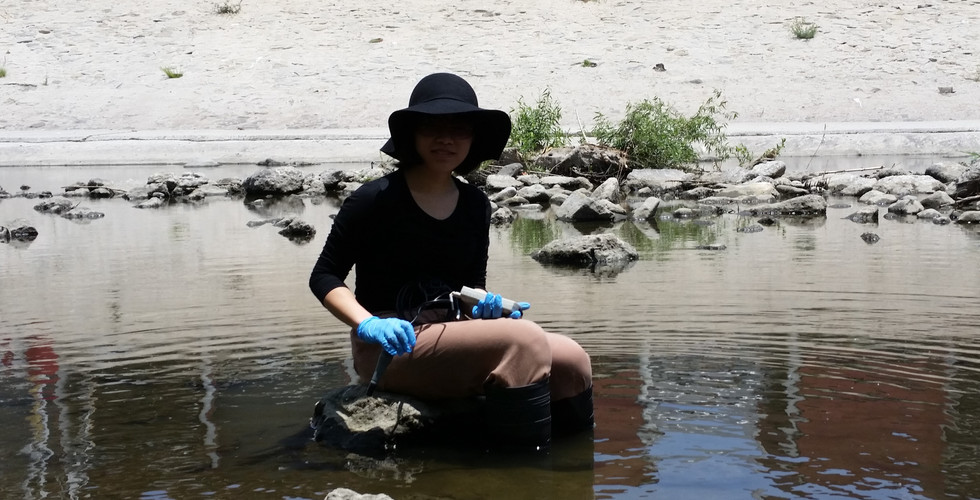CWH first Summer Science Friday
- Jun 9, 2017
- 4 min read
The Los Angeles River Watershed
Monitoring Program
Yareli Sanchez, B.S. in Biological Science, M.S. in Ecology, Ph.D candidate in Environmental Science & Engineering | UCLA
I have spent much of my scientific research and professional career working to understand the intricacies of life found in aquatic systems. From Midwest farming communities to mangrove forests in Mexico, exploring diverse geographies that face common challenges - how to balance competing uses of the environment.
I worked in a small coastal community in the mangrove forests of Baja California Sur, Mexico, measuring greenhouse gas emissions and nutrients in soils and porewater. It was the first time I had really experienced how the rhythms of life in a coastal community were intertwined with water. The economic benefits the community derived from its aquatic system often felt at odds with protecting and stewarding that resource. That research was a formative experience because I had the opportunity to witness and learn from the basic human pressures we place on aquatic ecosystems and how those pressures impact how ecosystem function and the plants and animals that live there.
After that research, I pursued opportunities to understand the role policy can play in not only supporting scientific research but valuing and preserving ecosystems and their benefits to society. This pursuit led me to a NOAA fellowship placement in the U.S. Senate, where I worked to find policy solutions for Midwestern communities re-imagining their waterfronts and seeking funding for revitalization because of blight and contamination. Communities and organizations also connected with us and sought federal support and legislative solutions to their concerns over water quality and the dwindling amount of trout in their local streams.
Citizens and experts reached out to my office, organized working groups to voice their concerns, and lent their voices and stories to legislative efforts. Community organizations collaborated with farmers and scientists and piloted their own solutions to local water resource problems, sharing with us the opportunities and obstacles they came across. This experience brought to the forefront the role citizens, scientist, and community groups can play in informing better policy, in valuing water resources, and in re-imagining their communities to integrate natural systems as water quality solutions and revitalization opportunities.
My experience in these diverse environments shifted the way I look at the river Angelenos see every day as they drive along the freeway or cross a bridge, and yet for many have erased from their public consciousness. The growth and urbanization of Los Angeles make it difficult to imagine a river that at one time hugged a landscape forested by oaks, willows, and sycamores and an LA River that swelled with a rich diversity of fish. Though the Los Angeles River was channelized to protect the region from the powerful and destructive floods that ravaged communities in the 1930’s, I can tell you stretches of the river are as alive and wild as any ecosystem I have studied.
Now I am a senior scientist with the CWH and the program director of the Los Angeles River Watershed Monitoring Program (LARWMP). In my time monitoring, I have seen the life this river and watershed support. I have seen the frogs, snakes, fish, bobcats, and a diversity of bird and plant species that inhabit the watershed. I have encountered Angelenos enjoying hikes along the river, swimming beneath its waterfalls, and kayaking and fishing along the banks of an urban oasis.
Every year for the past 10 years, teams of LARWMP scientists have collected the data that has informed our foundational understanding of the health of the Los Angeles River watershed. Prior to the development of the LARWMP program, monitoring was focused on compliance and very little was known about the condition of streams in the watershed, presenting an opportunity to better coordinate ongoing monitoring efforts and to promote collaboration between stakeholders of the Los Angeles River. LARWMP's a collaborative approach that provides a framework for comprehensive, periodic assessments of watershed health, and creates opportunities to align monitoring efforts with better resource management and public priorities.
This continuous monitoring effort has provided information to identify trends across the watershed, to inform better decisions, stronger planning efforts, and better-informed outreach and education about the health of the river, including how to use it safely. The monitoring data helps us understand how the river is responding to a complex web of pressures ranging from pollution, human alteration, to drought and climate change. Just like the fishermen neighboring the mangrove forests of Baja, Los Angeles faces competing needs and interests impacting the beneficial uses of the Los Angeles River. Our work will help inform a holistic approach to the management of the Los Angeles River, balancing those competing interests.
Even as I begin this new role, my experience monitoring the Los Angeles River has helped me appreciate the diversity of life at my doorstep and continue to appreciate the interconnection between communities and their rivers and streams. As in graduate school, I continue to explore the impact of human-caused disturbance on ecosystem function and the plants and animals that live there.
Join my team and me for Science Fridays to learn more about the health of our watershed, our monitoring work, and the Los Angeles River that connects our diverse communities together. Share what you want to know about the Los Angeles River Watershed Monitoring Program.















































